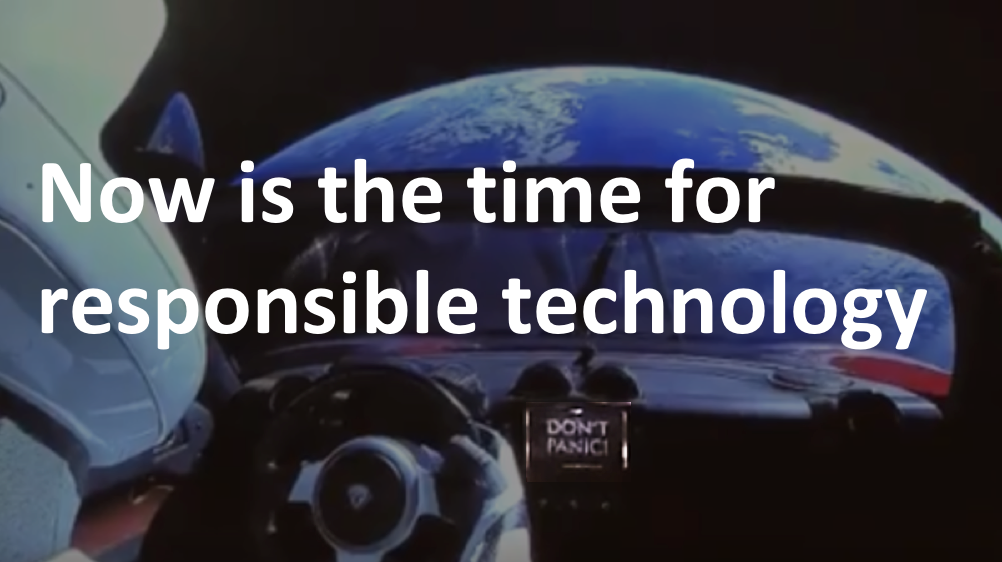Introducing the three Cs of Responsible Technology

More than ever, we are aware of the need for better practices to address key challenges and tensions between technology and society. Doteveryone has been working on making the consumer tech industry more responsible and accountable to society for over a year. It’s been a fascinating process of research, prototyping and learning. Our ideas have evolved as we’ve worked with others to figure out what might be both practical for real businesses, and effective in making tech better for people and society.
So what is Responsible Technology, and how do we know if we have it?
Responsible Technology considers the social impact it creates and seeks to understand and minimise its potential unintended consequences.
Responsible technologies:
- Do not knowingly create or deepen existing inequalities
- Recognise and respect everyone’s rights and dignity
- Give people confidence and trust in their use
We recognise that no technology product is going to be perfect, 100% responsible. This is why we haven’t set out a deeply detailed gold standard. Instead we are focusing our efforts on helping organisations along a journey to better ways of working; to incorporating responsibility into their mindset and continuous practice.
How did we get here?
In May 2017 we published an outline of ten aspects of responsible technology. It includes a mix of areas very specific to digital with broader business responsibilities related to tech. The list isn’t just about the technology itself — it’s about the people who develop, manage and invest in tech, about the users, individually and collectively, and the wider context.
Moving from ten to three
This was a good start. Feedback from events and experts suggested it was a useful set of considerations. And they formed the basis of our Trustworthy Tech Partners pilot programme. The programme took a cohort of tech organisations through exercises to explore and document their practices in each of these ten areas.
You can read more about the Trustworthy Tech Partners programme and our key findings here.
The programme allowed us to evolve and refine our definition to ensure it was fit for purpose and narrow the ten areas down to three. The three core concepts focus specifically on the technology product, service or application the company is creating as opposed to the business around it. We assume that the business, in wider terms (employment, governance, sustainably etc.) is already responsible. This is namely because guidance and standards on this are already available to support these elsewhere (e.g. B Corps, Responsible100 etc). It would not be worth our while replicating work that is already going on.
Responsibility is a practice
This is why the three areas consider the teams involved in making and operating the digital technologies. This gives us a very different lens through which to explore very current concerns about data. Teams that create responsible technology products will strive to consider:
Context — looking beyond the individual user and taking into account the technology’s potential impact and consequences on society
Technology that understands and respects the greater contexts and ecosystems it operates within and the potential impacts — positive, negative or a bit of both — it could have on the institutions, communities and relationships that make up society. This is about deciding on tradeoffs and explaining these to not only the direct stakeholders of your technology but those who might be affected.
Contribution — sharing how value is created in a transparent and understandable way
Contribution is about determining all of the ways and parties that contribute value to a technology product. This can include information or formal or informal labour. It’s about then sharing publicly these value flows — about who is involved in them, what is being exchanged — in a clear way that is easy to understand. .
Continuity — ensuring best practice in technology that accounts for real human lives
This is about creating and supporting products and services that are safe, secure and reliable for real, messy human lives and situations. It’s about ensuring people with different needs and abilities who might reasonably use them are accounted for with inclusive design, and that the technology is suitably supported and maintained. It’s about following appropriate best practices for the specific hardware and software elements of a product and anticipating and adapting to new needs and threats as they emerge.
These three core concepts show that some of our early principles are still strong; we remain interested in the holistic experience of technology. We don’t focus on specific technologies or applications, a fitness monitor for example is a wearable, an IOT device, a mobile app and may use machine learning. But when talking about responsibility and ethics what we’re concerned with is how these all fit together.
The three core concepts also highlight that responsibility isn’t just for when you are designing a product. It’s integral to the whole business model of a tech business — how a business uses technology to support its activities.
We’re looking forward to putting these into practice with useful tools and resources and systems for businesses in the coming months, and as always welcome feedback, so that we can make responsible technology the new normal.
For more information contact Laura James, Technology Principal ([email protected]) or Samantha Brown, Programme Manager ([email protected]).
Introducing the three Cs of Responsible Technology was originally published in Doteveryone on Medium, where people are continuing the conversation by highlighting and responding to this story.